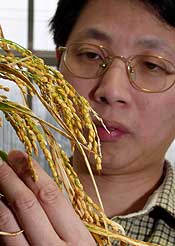Fayetteville, Arkansa
March 20, 2003
- By Fred Miller, Science Editor
- Arkansas Agricultural Experiment Station
- March 20, 2003
- fmiller@uark.edu
A key gene that controls tolerance to drought, salt and cold
in rice has been identified and studied by researchers at the
University of Arkansas Division of Agriculture.
- Understanding the gene's function may be important to
breeders developing rice varieties that can tolerate
drought and salt in areas of eastern Arkansas where ground
water sources are declining in quantity and quality, said
Yinong Yang, molecular biologist for the Arkansas
Agricultural Experiment Station.
-
- Yang said the gene, designated "mitogen-activated
protein kinase 5," or MAPK5, also may be used to improve
stress tolerance in other cereal crops.
-
- It was one of more than 200 rice genes isolated by
Yang and his research group that are associated with
disease resistance and stress tolerance. Understanding
exactly what each of these genes does requires subjecting
them one-by-one to molecular, biochemical, genetic and
genomic analysis.
- "We can't study all of them in detail, so we selected
the genes that seemed most important and started with
MAPK5," Yang said.
- An article by Yang and research associate Lizhong
Xiong, describing their detailed study of the gene, has
been published in the March issue of The Plant Cell, the
leading journal of plant biology by the American Society
of Plant Biologists.
-
|
 |
|
Yinong Yang,
UA molecular biologist, is studying the functions of a gene
that triggers stress tolerance in rice. In experimental
transgenic rice plants --- some with the gene suppressed and
others with the gene over-expressed --- he is measuring the
plants' responses to drought, salt and cold stresses.
|
- MAPK5 in rice gene encodes kinase, a protein that
regulates plant defense response to various environmental
stresses. "This gene is activated in rice plants by abiotic
stress, including drought, salinity and cold," Yang said. "It
is also induced by biotic stresses such as fungal and
bacterial pathogens."
-
- He said at least five research groups in Japan, Taiwan and
the U.S. have isolated the same gene, but only Yang's group
has identified its biological function with transgenic
analysis.
-
- To study the gene's function, Yang and Xiong genetically
modified rice plants in two ways. In some of the plants, MAPK5
was suppressed so that it would remain dormant under stress.
In other plants, the gene was over-expressed, meaning that it
would respond faster or stronger to stress. The results were
compared to control plants in which the gene was not modified.
-
- "The over-expressed plants had a higher survival rate
under drought, salt and cold conditions," Yang said. "The
suppressed plants tended to die under the same levels of
stress."
-
- Yang said their tests demonstrated that MAPK5 is a
positive regulatory gene for abiotic stress tolerance in rice
plants. "Regulatory genes are the 'white collar' workers in
biology," he said. "They pass along cellular signals that turn
'blue collar' structural genes on or off.
-
- "Regulatory genes and structure genes work together to
control plant function," Yang said. "Some genes cross the
lines to do the work of both types."
-
- Yang's and Xiong's article in The Plant Cell can be read
online at
www.plantcell.org/cgi/content/full/15/3/745.
|